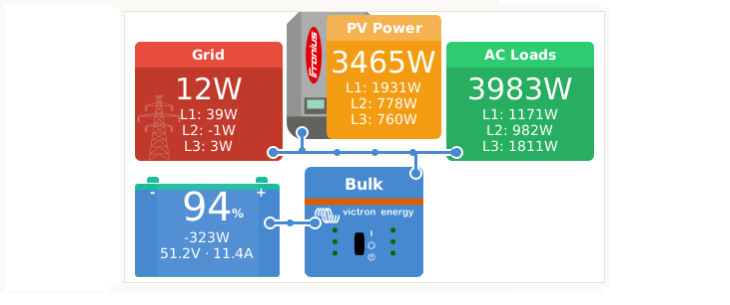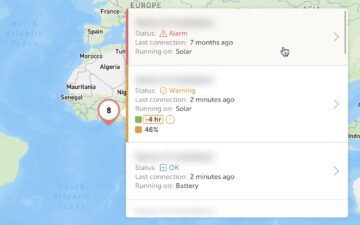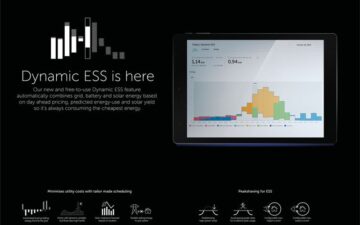
Update 3rd Mar – v1.35: v1.35 has been released, fixing a bmv related energy (kWh) calculation issue. Visible in the graphs on the Solar yield and consumption tab on the VRM portal.
Update 1st Mar – v1.34: version v1.32 accidentally created problems in certain VE.Can installations. This has been fixed in v1.34, already released this morning.
Update 25th Feb – v1.33: the update accidentally removed the Chinese fonts from the system. This has been fixed in v1.33, already released this morning.
Original post:
Color Control version v1.32 is now available. The main highlight is the expansion of Hub-4, our solution for grid-parallel energy storage: split- and three-phase systems are now also possible!
Split- or three-phase Hub-4 – how does that work?
In such a system, there is at least one Multi (or Quattro) installed on each phase. They will automatically charge or discharge, depending on the available PV power versus the power draw from the loads.
Excess PV power available:
When the system as a whole, ie. the sum of power on all phases, produces power (PV power exceeds consumption), the Multis on the phases with a net power production will be set to charge the battery. Multis on phases with a net power usage, Ppv < Pload, will be idling.
Shortage of PV power (typically in the evening and at night):
When the system as a whole consumes power, ie the consumption exceeds PV production at that moment, the Multis on the phases with a net power usage will discharge the battery to compensate for the shortage. And the Multis on phases with a net power production will be idling.
Installation requirements and details:
- The Multis need to be configured as a three-phase system. Use VE.Bus Quick Configure or VE.Bus System Configurator for this.
-
Update all Multis to firmware 406 or newer
-
Install the Hub-4 Assistant in all units: all the phase-masters but also all slaves (if any)
-
Three phase loads: it is possible to connect three-phase loads to the AC out of the Multis, also referred to as the `UPS-output` in a Hub-4 system. Those loads will be powered from the battery during a power failure.
More information in the updated Chapter 3 of the Hub-4 manual.
Note that it already was possible to use one Multi in a multi-phase installation. Use the three-phase energy meter, and enable phase-compensation in the Hub-4 settings on the Color Control GX. For details see the Hub-4 manual.
Full change log of v1.32
- Add three-phase support to hub-4 (requires VE.Bus firmware 406 or newer)
- Improve hub-4 algorithm when using wireless link to the AC meter
- Fix bug in kWh calculations: systems with a Multi/Quattro, MPPT Solar Charger, BMV (and DC System set to disabled) would report excessive solar consumption and feedback on the Solar yield and Consumption tab on the VRM Portal. And no, or very little consumption from the battery (blue bars). This bug was introduced in v1.30, released Dec 1st
- Improve kWh-calculations: a BMV is no longer required to calculate kWh data for systems with a Multi/Quattro, Solar Chargers and no other DC chargers or loads.
- Improve kWh-calculations: in systems with a DC System (and that corresponding setting, Has DC System enabled) the energy used by DC loads is now added into the calculations.
- Show Fronius logo for Fronius PV Inverter, instead of a generic PV Inverter graphic
- Increase chance of having a connection for Remote Support and Remote Console: ssh tunnel script now tries port 22, 80 and 443, instead of only port 80.
- Improve translations
How to install this new firmware?
By default, a Color Control will automatically download and install new firmware via the internet, as soon as there is a new version available. For a manual update, follow instructions here.
Thats it for now, enjoy and we’ll be working on more improvements in the meantime.
Best regards,
Matthijs Vader


















 #victronenergy #adventure
#victronenergy #adventure
 ELECTRICS
ELECTRICS 
